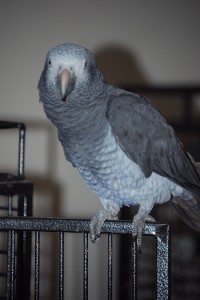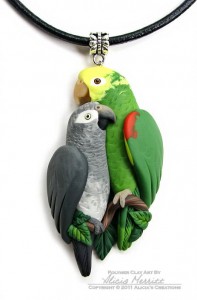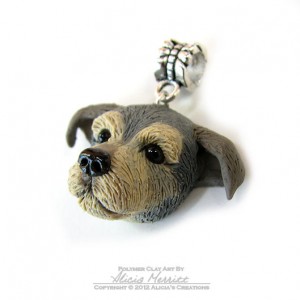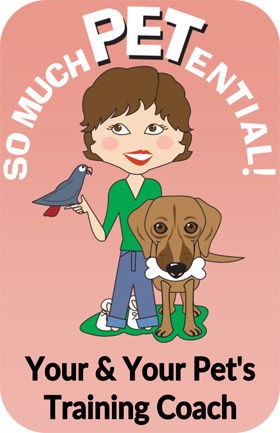pet bird
Alicia Merritt Creates Parrot Jewelry Out Of Love
NOTE: I have a new pet behavior blog located at http://www.SoMuchPETential.com/blog. Thanks!
Alicia Merritt has always loved animals. Growing up in the Philippines, she’s had some pretty unusual pets – goats, pigs, lizards and chickens. Well, that is, in addition to her cats and dogs.
Her fascination with parrots arrived when her cockatiel did. Alicia was 11 years old at the time. Since then, she has had numerous parrots and currently shares her home with two beautifully, loving, silly Solomon Island Eclectus Parrots.
Well, she also shares her home with three adopted poodles.
Alicia discovered her talent for polymer clay sculpture when she was having health issues and looking for something to do with her limited energy. I’ve admired her work for years. I’m enclosing a couple pictures of her animals. (Note that she specializes in birds. She charges more for custom dog sculptures.)
To see all of her pieces or inquire about custom work, please visit her website: http://www.parrotjewelry.com.
My Thoughts On Taming A Pet Parrot
NOTE: I have a new pet behavior blog located at http://www.SoMuchPETential.com/blog. Thanks!
(one of my past Hyde Park Living columns)
Alright, I’ve got to speak my mind this month. I have heard so many people and seen so many web sites talking about ‘taming’ birds.
 Knowing what I know about behavior and being as compassionate as I am about other living beings, I hate that phrase. It makes me cringe actually because taming to me infers dominance and force. And dominance and force in no way helps build a relationship of trust and foster quality of life.
Knowing what I know about behavior and being as compassionate as I am about other living beings, I hate that phrase. It makes me cringe actually because taming to me infers dominance and force. And dominance and force in no way helps build a relationship of trust and foster quality of life.
Let me share some excerpts of ‘taming’ tactics suggested on web sites.
“If you make a fist and bend your wrist as far as it will go, you’ll notice that the skin on the back of the fist becomes very tight. Bring your fist up to the bird very slowly, finding out where its striking range is….The Fist, brought slowly toward the bird’s beak, can be used to control the bird, move it away from you, hold it off and let it know that you are not about to be driven out of the territory.”
“If your bird is so aggressive that you cannot safely place your hand inside its cage, try wearing thick oven mitts on your hands. If your bird bites the mitt, gently push in towards his beak rather than pulling away. This will eventually teach him that no matter how hard he bites you, he cannot make your hand disappear.”
“You have to expect the bites and be prepared to take them if need be..reacting to those bites is just about the worst thing you can do. Once the bird discovers that his bites WILL NOT back you down..he will stop trying.”
Let me repeat that with a BIG question mark. “Once the bird discovers that his bites WILL NOT back you down…he will stop trying.” REALLY? Some months back I devoted an entire column dispelling the reasons people use for why parrots bite. I’ve pulled a paragraph from it below.
Why then do birds bite humans? Well, for one humans who get bit generally aren’t very good listeners when it comes to watching their bird’s body language. They don’t allow their bird to nonagressively warn them to back off. Instead they push the limit and they have their body parts where they shouldn’t be (that’d be too close to a bird’s beak when the bird doesn’t want you there). They teach their birds that nonaggressive body language just doesn’t work in communicating to aggressive, grouchy or dominant humans.
I used to get bit, and bit hard, by Dreyfuss until I began studying behavior with Susan Friedman, Ph.D. about 10 years ago. Since then the only rare bites I have gotten have been when “I” have not paid attention to her body language.
My compassionate side shutters to think of that poor bird who has to come face to face with a person’s fist in order to learn how to be calm. In science, they call this ‘learned helplessness.’ It is when an animal is subjected to an aversive stimulus from which it cannot escape and it eventually stops trying because learns it is utterly helpless to change the situation. A great example of this is Jaycee Dugard, who stopped trying to escape her kidnapper, abuser and father to her children, after she realized it would do her no good to try.
Think about under what circumstances you are most eager to learn and you are most likely to succeed. Think about your favorite role model or teacher growing up or a favorite boss who inspires you to do your very best simply by believing in you and letting you learn from your own experiences.
That’s the type of person we need to be to our pets – a partner, friend and cheerleader, not a dictator and punisher. Instead of thinking about ‘taming’ your pet, think about setting your pet up for success. Your role should be to evoke joy in living, to make learning pure fun, and to make being with you the best choice ever because only good things come when you are around.
This Parrot Loves His Bunny
NOTE: I have a new pet behavior blog located at http://www.SoMuchPETential.com/blog. Thanks!
I love this video because it reminds me so much of Chester. Ringneck parakeets have so much curiosity and such a zest for life.
Solving Pet Parrot Phobic Behavior – Positively
NOTE: I have a new pet behavior blog located at http://www.SoMuchPETential.com/blog. Thanks!
Note: This is a past column from my Hyde Park Living pet behavior column.
Every once in awhile you have the opportunity to read about my personal stories as they pertain to modifying pet behaviors in the most positive, least intrusive ways. I’ve been studying this for nearly four years now. Not only has it completely changed my relationship with my three parrots, I find it absolutely fascinating.
This month, I will focus on fear. With birds especially, I’ve often heard people talk of their pet’s sudden neurotic, phobic behaviors. Out of the blue, for no apparent reason, their loving companion will scream, lunge or try to escape  the hands that up until that moment had only been associated with positive things.
the hands that up until that moment had only been associated with positive things.
I know about this, unfortunately, from firsthand knowledge. My loving Barnaby Timneh African Grey, who normally would be very happy spending his entire day with his face pressed against mine (of course it would have to be with the occasional play break), would suddenly ‘out of the blue’ panic when he stepped onto my arm. He’d scream with horror in his voice, breathe heavily, and then take off. If you’ve ever experienced the unconditional love of an animal, you can probably understand it is completely heartbreaking when you are thrust into the portrayal of some evil monster – and you don’t even know why.
Each time it would happen with Barnaby, I’d have to go through a systematic desensitization plan to help him overcome his anxiety. Because we have a long history of trust, we were able to work through this fairly quickly, but my training taught me there had to be a reason for this reoccurring behavior. And there also had to be a way of eliminating or minimizing the frequency of it. Behavior, I know, doesn’t ever happen willy nilly. It is always triggered by something in the environment. And the consequences of that behavior are what either maintains, builds or extinguishes it.
Hmm. Actually it became fairly easy to figure out once I put on my behavior analysis hat.
There is a window in the birds’ room that faces the street. On sunny days, when a car drives past, the light that reflects from the metal and glass makes a brilliant pass from one wall to the next. A pretty scary demon to a Timneh teddy bear no longer than a ruler. If my neighbor parks her car in a certain spot at a certain time of day and Barnaby happens to be way up high, that same evil light hovers. Each time that Barnaby jumped on my arm, only to be terrified, that same ‘trigger’ light just happened to be coming from the street.
My mentor and teacher, Dr. Susan Friedman – a respected psychologist and behaviorist – helped me to understand. Purely based on my poor timing, in Barnaby’s mind, I got associated with the light. And that was not a good thing to be paired with.
Barnaby had two types of behaviors going on. One was an automatic, involuntary response to a bright light (panic scream, escape). In scientific terminology, this is called an unconditioned or respondent behavior because it wasn’t something that Barnaby learned in the way that he came to know stepping up generally meant only good things would follow. On the other hand, his stepping up behavior is most definitely learned. Scientists call that operant learning.
Now, think of the use of a clicker. The clicker in and of itself is meaningless to an animal. It only acquires value to that animal when a good trainer repeatedly pairs the sound with a treat. Then the click acquires reinforcing value.
This same type of association was going on with Barnaby, only it was a negative one. Being on my arm – something that had always given him positive reinforcement in the past – when the light (remember, something that causes an unconditioned fear response) came through the window, was being paired with that fear response. Just as the words ‘good boy’ have become associated with safflower seeds, his being on my arm had become associated with that awful light.
Once this became clear, working toward a solution really wasn’t that difficult. What I learned from Susan (and so many great people on Susan’s international parrot behavior listserve) is how to modify Barnaby’s environment so as to set him up for success. When I’m working from home, I try to remember to close their shade at a certain time. But if the shade is up, and there is that dangerous light outside (at least in his eyes), I absolutely will not pick him up. Instead, he’s learned to go inside his cage at that time. That one small adjustment has meant the difference between a pet who became instantly phobic of me – on a more frequent basis – to one who hasn’t exhibited those behaviors once since I figured it all out. So, it really wasn’t just some irrational fear after all.
This isn’t to say that something else in the future may pop up, that will cause that same fear response. Barnaby is a living being, and, as life goes, behaviors evolve all the time to adapt to the environment. But next time, I’m going to be better equipped to send those awful monsters packing so Barnaby can just focus on having fun.
Note To Barnaby About Training With Positive Reinforcement
NOTE: I have a new pet behavior blog located at http://www.SoMuchPETential.com/blog. Thanks!
Dear Barnaby, I appreciate that you want to be my helper in training Chester to wave. But please remember, training with positive reinforcement means only rewarding the CORRECT behavior.
(by the way, Barnaby is my Timneh African Grey)
















